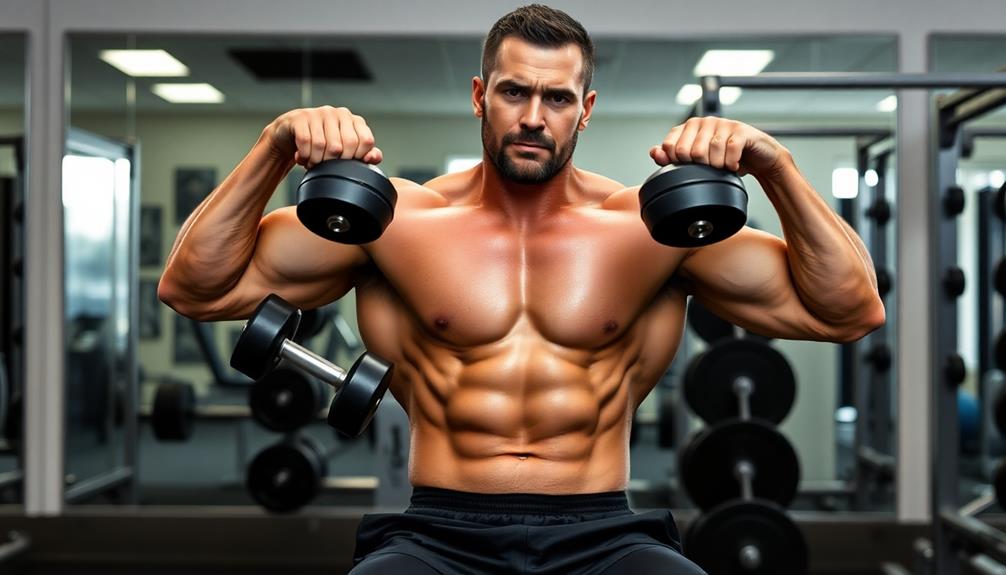To build larger muscles through hypertrophy, focus on compound and isolation exercises for your upper body. Perform 3-4 sets of 8-12 reps per exercise, resting 60-90 seconds between sets. Prioritize proper form and technique to maximize muscle engagement and prevent injuries. Include exercises like bench presses, rows, overhead presses, and bicep curls in your routine. Allow adequate rest between workouts for muscle recovery and growth. Gradually increase weight or reps to ensure progressive overload. Pair your workout routine with proper nutrition and sleep for best results. Discover how to structure your workouts and fine-tune your approach for maximum muscle gains.
Core Insight
- Focus on compound exercises like bench press, rows, and overhead press for overall upper body development.
- Aim for 8-12 repetitions per set with 3-4 sets per exercise to stimulate muscle growth.
- Incorporate isolation exercises like bicep curls and tricep extensions to target specific muscle groups.
- Maintain proper form and technique, emphasizing controlled movements and full range of motion.
- Allow adequate rest between workouts and prioritize recovery through proper nutrition and sleep.
Understanding Hypertrophy

Hypertrophy is the increase in muscle size that happens when you lift weights. When you do hypertrophy workouts, you cause tiny amounts of damage to your muscle fibers. This damage triggers your body to repair the muscles, leading to muscle growth and increased strength. While steroids can speed up this process, there are safer ways to support muscle growth without the risks.
To get hypertrophy, focus on three key things: lifting heavy weights, causing muscle damage, and creating metabolic stress. Lift heavy weights for fewer reps to create mechanical tension. Use a full range of motion and do eccentric movements to cause muscle damage. Do higher reps with shorter rest periods to create metabolic stress.
Exercise Selection

Selecting the right exercises is key to building muscle in your upper body. To get the most growth, include both compound and isolation exercises that work the major muscle groups. Using cooling towels during your workouts can help you stay comfortable, especially during longer sessions.
Compound exercises to include:
- Bench press for chest, shoulders, and triceps
- Pull-ups or lat pulldowns for back and biceps
- Overhead press for shoulders and upper chest
Isolation exercises to add:
- Bicep curls for biceps
- Tricep extensions for triceps
- Lateral raises for side shoulders
Focus on compound exercises first since they work several muscles at once, leading to more overall growth. Then, do isolation exercises to target specific muscles for a complete upper body workout. Change up the exercises you do from time to time to avoid plateaus and keep challenging your muscles.
Proper Form and Technique

Proper form is key when doing upper body exercises. It helps you build muscle and avoid getting hurt. Focus on staying in control, using the right muscles, and moving through the full range of motion. Here are the main points for three important exercises:
| Exercise | Key Form Points | Common Mistakes |
|---|---|---|
| Bench Press | Keep feet flat and shoulders back | Don't bounce the bar or arch your back |
| Pull-ups | Tighten your core and get your chin over the bar | Avoid swinging and do full reps |
| Shoulder Press | Keep elbows at a right angle and core tight | Don't arch your back or let elbows flare out |
| Bicep Curls | Keep elbows still and use full range of motion | Don't swing the weights or do half reps |
Remember to breathe right. Breathe in as you lower the weight and breathe out as you lift it. Start light to get your form right before using heavier weights. If you're not sure about your technique, ask a trainer for help.
Rep Ranges and Sets

Once you've learned the right form, it's important to focus on reps and sets for the best muscle growth. Aim for 8-12 reps per set to balance muscle tension and stress. Do 3-4 sets per exercise for enough volume without overdoing it. Be careful with any supplements, and talk to an expert first.
For sets, start with 3-4 for big exercises like bench presses or rows. For smaller exercises like bicep curls, 2-3 sets are usually enough. Rest for 60-90 seconds between sets to keep intensity while letting your body recover.
As you get better, you can change these numbers. Some people do well with higher (12-15) or lower (6-8) reps for certain exercises. Try different things to see what works best for you, but always focus on good form over adding weight or reps.
Rest and Recovery

Rest and recovery are crucial for building muscle effectively. To maximize growth, give your body enough time to repair and rebuild between workouts. Rest your upper body for at least one full day before training it again. Taking Epsom salt baths can help your muscles feel better and help you relax, improving overall recovery.
Sleeping well is important because that's when your body releases growth hormone and fixes damaged tissue. Try to get 7-9 hours of sleep each night. Eating enough protein is also key for supporting muscle growth and repair.
Light activities like stretching, yoga, or easy cardio can boost blood flow and reduce muscle soreness. This is called active recovery. Pay attention to your body and adjust your rest time if needed. Overtraining can slow down your progress, so be sure to give yourself enough rest.
Progressive Overload

Progressive overload is the key to building muscle effectively. It means slowly making your muscles work harder over time. While supplements can help, natural methods are usually safer and more reliable. Here are some ways to use progressive overload in your upper body training:
- Use heavier weights: Gradually increase the weight you lift.
- Do more reps: Complete more repetitions with the same weight.
- Increase volume: Do additional sets for each exercise.
- Perfect your form: Work on using the right technique.
- Take shorter rests: Spend less time recovering between sets.
- Train more often: Work each muscle group more frequently.
Nutrition for Muscle Growth

If you want to build muscle, you need to eat right. Make sure you get enough protein, about 1.6 to 2.2 grams for every kilogram you weigh. Protein helps your muscles recover and grow. Carbs are important too, since they give you energy for your workouts. Don't forget about healthy fats, which your body needs to make hormones.
After your workout, think about having a protein bar with 15-30g of protein. They're easy to grab when you're busy or need a quick bite. These can help your muscles recover and grow.
To gain muscle, you'll need to eat a bit more than usual. Aim for 300-500 calories extra per day. When you eat matters too. Try to have a meal with protein and carbs within half an hour after exercising. This supports recovery.
Drink plenty of water and think about taking supplements like creatine. When combined with good nutrition and training, creatine can boost muscle growth.
Sample Workout Routines

Sample workout plans are a great way to get started building muscle. Following a plan helps you work the right muscles and slowly increase the challenge over time. After your workouts, using a foam roller can help your muscles recover and relax.
Try this basic upper body routine:
- Chest and triceps: 3 sets of 8-10 bench presses, 3 sets of 10-12 incline dumbbell presses, 3 sets of 12-15 tricep pushdowns
- Back and biceps: 3 sets of pull-ups until you can't do more, 3 sets of 8-10 bent-over rows, 3 sets of 10-12 bicep curls
- Shoulders: 3 sets of 8-10 overhead presses, 3 sets of 12-15 lateral raises
- Core: 3 sets of 30-60 second planks, 3 sets of 15-20 Russian twists on each side
Do this routine 2-3 times a week. Make sure to rest enough between workouts.
Frequently Asked Questions
How Long Does It Take to See Noticeable Muscle Gains?
You'll typically notice visible muscle gains within 4-8 weeks of consistent strength training. However, factors like diet, genetics, and workout intensity can affect your progress. Remember, everyone's body responds differently, so be patient with your journey.
Can I Build Muscle Without Using Supplements?
Yes, you can build muscle without supplements. You'll need to focus on a balanced diet with adequate protein, consistent strength training, and proper rest. Supplements aren't essential; they're just optional aids for some people's fitness journeys.
Should I Train to Failure for Every Set?
You shouldn't train to failure for every set. It's best to leave 1-2 reps in reserve for most sets. This approach helps prevent overtraining, reduces injury risk, and allows for better recovery between workouts.
Is It Necessary to Change My Workout Routine Regularly?
You should periodically change your workout routine to prevent plateaus and keep your muscles challenged. However, it's not necessary to do this frequently. Every 6-8 weeks is often enough to maintain progress and prevent boredom.
How Do I Prevent Muscle Imbalances When Focusing on Upper Body Hypertrophy?
To prevent muscle imbalances, you'll need to include exercises for all major upper body muscle groups. Don't neglect any areas. Incorporate compound movements and guarantee you're using proper form. Balance your training volume across muscle groups.

